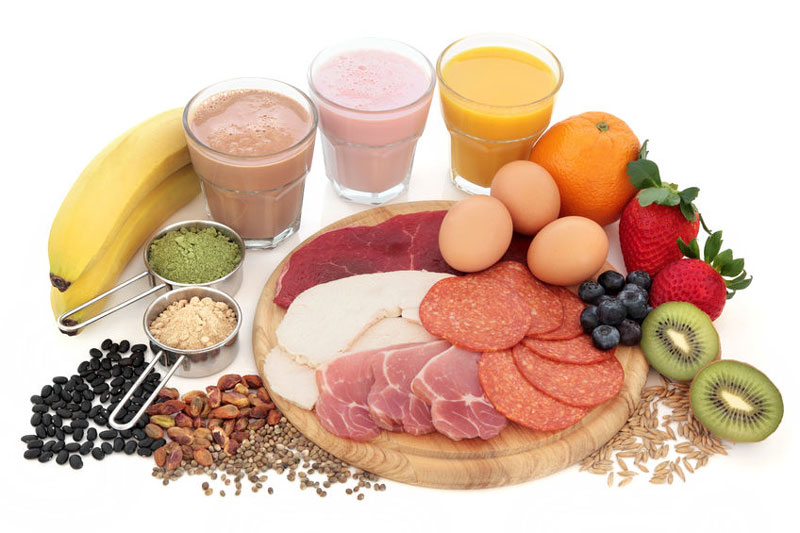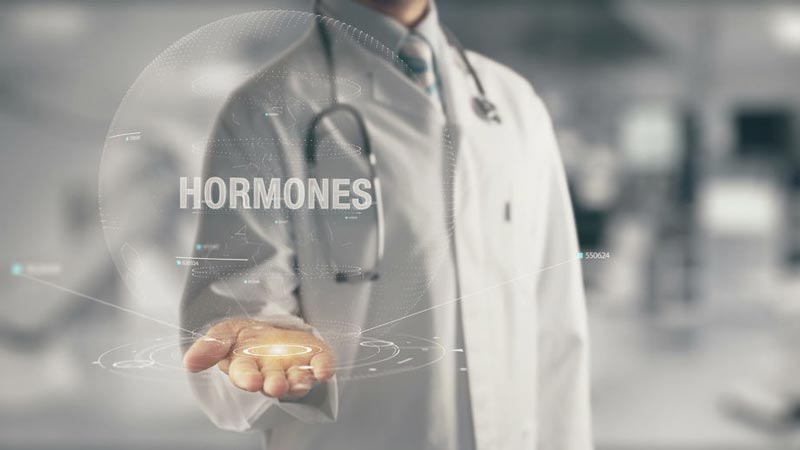December 2017 NewsBlast | Article 1
22 Dec 2017 / joeNAFC NewsBlast - December 2017 | Ed 2
How important is it to consume Fast vs. Slow Proteins?
Written by: Dr. Max MacCloud, DO, ND, PhD, The Health, Fitness & Nutrition Ninja
Source: My Body Symphony

Copyright: marilyna / 123RF Stock Photo
People Always Ask Me…
How important is it to consume fast and slow proteins?
Simple answer: Not very important, what matters is quality & quantity.
Explanation:
This is one of those things that arose from some company’s marketing pitch. They wanted to get people (wannabe muscle heads) to buy their protein formulation because it contains a combination of “fast-absorbing” and “slower-absorbing” proteins to maximize muscle gains.
The rationale is that it’s vital
for protein to be available at all times to maximize anabolic (rebuilding) of muscle following the breakdown associated with intense training.
There’s a great recent commercial of a few older ladies where one is telling the other about posting various pictures on her wall referring to Facebook. There are several pictures posted on the wall behind her… and the other woman says, that that’s not how it works and the first woman says that she “unfriends” the woman that tells her she’s mistaken. Then the second woman says in exasperation, “That’s not how it works, that’s not how ANY of this works!”
I love that commercial because it applies to SO MANY freaking things these days. So many people are clueless about how things really work since the majority of their education on many topics consists of a few short blurbs they read online or heard in a video.
When it comes to protein (amino acids actually)
being available to rebuild or build muscle, the fast vs. slow absorbing proteins are virtually irrelevant in terms of actual results. Proteins take time to digest and be absorbed via an elaborate digestive, absorption and assimilation process involving several vital organs. Ultimately, the amino acids that are the building blocks of proteins as well as muscles and thousands of other substances in the body, end up in the liver. The liver is the body’s primary factory to build all kinds of proteins (among other things).
So, when our muscle have been damaged
or otherwise stress due to intense exercise, they rely on a variety of chemical substances manufactured in the liver to rebuild. The liver maintains a modest although the transient supply of raw materials to build various substances from that are then transported throughout the body via the blood.
If you are properly nourished
(which you had better be if you want to rebuild and add muscle mass) then your liver and tissues will have sufficient amino acids and other vital substances available 24/7 to support that rebuilding process.
So, it isn’t a matter of consuming fast and slow proteins, it is simply a matter of consuming enough quality protein on a consistent basis.
To learn how to compare protein quality from different sources, go to: My Body Symphony
and have the Protein Quality Comparison Checklist emailed to you.
Written by: Dr. Max MacCloud, DO, ND, PhD, The Health, Fitness & Nutrition Ninja
November 2017 NewsBlast | Article 4
24 Nov 2017 / NAFCNAFC NewsBlast - Novemeber 2017 | Ed 2
The Top 10 Exercises to Avoid | Why Demand for Yoga Instructors & Trainers?
Written by: Tammy LeBoss, The FitPro Foodie
Contributing Writer: Logan Cahoon
Sources: New York Times, Stuart McGill, NAFC Mat and Reformer

YOU ARE WANTED BY THE NAFC!
Do you want to make a difference in the fitness industry? According to a New York Times article published in 2012, a growing body of medical evidence says that for many people, commonly taught yoga poses are inherently risky. Reports of yoga injuries appeared decades ago, published in some of the world’s most respected journals, including The Journal of the American Medical Association. The problems ranged from relatively mild injuries to permanent disabilities. Wonder why?
Perhaps this is due to many sitting for long periods, hips in a flexed state and then rushing off to the gym or yoga studio. Moving too quickly into squats (more hip flexion), and contorting, bending and twisting too quickly in yoga poses which may not be appropriate for many. Many are unaware that holding postures for long periods, excessive extension of the neck, and hyperflexion of the neck, can create further issues.
In addition, yoga teachers are reporting how yoga can heal, yet they also report how yoga can hurt. In 2009, a study at Columbia University’s College of Physicians and Surgeons published a worldwide survey of yoga teachers, therapists and doctors revealed that the largest number of injuries centered on the lower back. This study, amongst others, has pointed to a decided shift in the perception of how risky yoga poses may be.
B.K.S. Iyengar, considered to be one of the foremost yoga teachers in the world emphasized that in Cobra pose, the head should arch “as far back as possible”. Although the idea involves stimulating organ functioning and thus, well-intended, for even advanced practitioners, this motion is a recipe for injury and pain.
Bureau of Labor Statistics estimates that jobs in personal training and fitness instruction will increase by 24% between 2010 and 2020.
Fitness instructors must develop critical-thinking skills, and always consider the Risk/Benefit™ factors for each and every exercise they recommend. The following are 10 exercises to avoid, or to approach with extreme caution:
- Headstand, Plow Pose and Short Spine (in Pilates)-may stress the cervical spine.
- Wheel and other deep backbends-know how to offer modifications.
- Extreme twists- learn best ways to twist and know when to apply neutralizing exercises.
- Pilate 100’s- Pilates was popularized by conditioned dancers and athletes. Performing the 100’s may not be appropriate for your clients. Create modifications such as performing the 100’s while standing, or learn how to use props as support.
- Prone back extensions such as Cobra, Locust, Wheel and Full Swan (in Pilates)-these exercises are potentially dangerous if bending incorrectly from the lumbar spine.
- Handstand-challenges shoulder stability within a shallow, vulnerable joint.
- 100 Crunch Challenges- too much flexion may cause bulging discs. (Stuart McGill)
- Chaturanga or Triceps Dips- puts a heavy load on rotation cuffs, and thus a high risk of shoulder injury.
- Shoulder Shrugs -harmful to the shoulder joint and should be avoided.
- Seated and Preacher Biceps Curls-Pulls on the head of the humerus.
The fitness industry needs more qualified instructors.
The demand for Personal trainers, yoga and Pilates continue to grow. The United States Department of Labor’s Bureau of Labor Statistics estimates that jobs in personal training and fitness instruction will increase by 24% between 2010 and 2020. This is faster than the average 14% expansion for all occupations. In CNN Money reports, The Best 100 Jobs in America included Personal Training at #18 in 2012, while Yoga and Pilates Instructors are #10 in 2015. Personal training has seen many changes over the years so we know it is growing. To stay in the game, trainers must take a strong look at where our industry is heading. Experts believe that education/certification, technology, variability in training formats, and career stability should take precedence if to succeed in a rapidly-growing industry.
Don’t get left behind. Keep learning!
Written by: Tammy LeBoss, The FitPro Foodie Contributing Writer: Logan Cahoon
Novemeber 2017 NewsBlast | Article 3
22 Nov 2017 / NAFCNAFC NewsBlast - October 2017 | Ed 3
Hormones - HGH/Testosterone, Yes or No?
Written by: Dr. Max MacCloud, DO, ND, PhD, The Health, Fitness & Nutrition Ninja
Source: My Body Symphony

Copyright: ankabala / 123RF Stock Photo
People Always Ask Me…
Should I try and get my doctor to prescribe HGH and/or Testosterone to help me add muscle?
Athletes have been looking for “an edge” from the earliest times. These days it has spilled over into the general population. It’s not just competitive athletes who are looking for an edge, it’s almost everyone, even people that barely workout! It’s INSANE.
Here’s what I tell
people when they ask about taking supplemental hormones to build muscle. First I ask them why they want more muscle. Of course, there are several legitimate reasons but I just want to see if they actually have one. Next, I ask them what they’ve been doing and what their results are. If they aren’t training hard and eating right I just walk away in disgust and tell them to stop wasting my time (freaking morons).
Now, for those that are serious
and have been doing the basic essential things, I’ll dig a bit deeper. I ask what they are doing to stimulate the production, release, and balance of their own endogenously produced anabolic hormones (hGH, testosterone, estrogen, and insulin). Typically I get a blank stare at this point. Then I explain that there are several things that they can do to increase their own HGH and Testosterone production and secretion of these important hormones and before they should consider taking exogenous hormones (i.e., pharmaceuticals) they should at least maximize their body’s production and release first.
Here are my quick and dirty recommendations
to do just that. First and foremost, make sure you’re getting enough quality protein and healthy fats in your diet, they are the building blocks of hormones. Next, make sure that you’re doing some heavy movements at least a few times a week. It takes significant, nearly all-out effort to stimulate the release of key anabolic hormones like HGH and Testosterone. Get enough high-quality sleep and pay attention to proper sleep hygiene. Incorporate High-Intensity Interval Training a few times a week. Try doing some Intermittent Modified Fasting a few days a week.
The science and physiology
behind all of those recommendations gets pretty intense so feel free to spend some time searching them for a better understanding of why they work to boost HGH, Testosterone, and to balance many other hormones BUT in the meantime start experimenting with them.
Many books have been written
So, just when people were finally starting to “get it” there is this insane resurgence of high meat consumption. Much of the frenzy was fed by the “CrossFit” phenomenon. That will be the topic of another post (yes, I have some issues with it as well).
See the link below to my 21 Day Build-It Intensive that helps to explain each of the recommendation in more detail and puts them in the context of a program to try.
Click here for our Website: My Body Symphony
Written by: Dr. Max MacCloud, DO, ND, PhD, The Health, Fitness & Nutrition Ninja
begin ... prev 1 2 3 4 5 6 7 8 9 10 11 12 13

